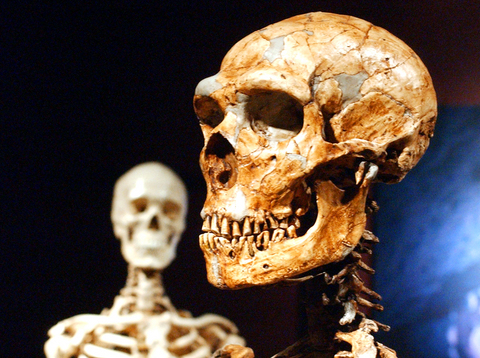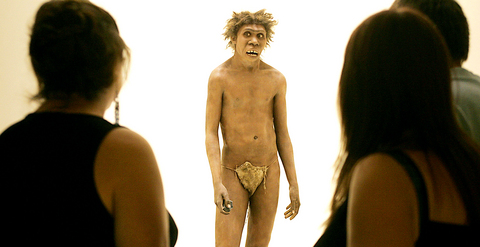The final resting place of the last Neanderthals may have been unearthed by fossil-hunters excavating deep inside a cave in Gibraltar.
Primitive stone tools and remnants from wood fires recovered from the vast Gorham's cave on the easternmost face of the Rock suggest Neanderthals found refuge there, and clung to life for thousands of years after they had died out elsewhere.
Carbon dating of charcoal fragments excavated alongside spear points and basic cutting tools indicates the cave was home to a group of around 15 Neanderthals at least 28,000 years ago, and possibly as recently as 24,000 years ago. Previously uncovered remains lead scientists to believe the Neanderthals died out in Europe and elsewhere some 35,000 years ago.

PHOTOS: AFP
The discovery marks more clearly than ever before the time of death of our closest relative, and completes one of the most dramatic chapters in human evolution.
Today, Gorham's cave is perched on a cliff face lapped by the Mediterranean, but the view from the east-facing entrance was once of rolling sand dunes pocked with vegetation. A freshwater stream running down from the north led to the sea 4.8km away.
“For the Neanderthals, this was a great place to be. The view would have been breathtaking, and they would have literally been able to see where their next meal was coming from,” said Chris Stringer, a scientist on the project at the Natural History Museum in London. “The evidence supports the idea that this was one of their last survival spots, one of their final outposts.”

The sea level was around 100m lower in Neanderthal times as vast quantities of water were locked up in glaciers that encroached from the poles and smothered Scotland in sheets of ice 3.2km thick.
Clive Finlayson at the Gibraltar Museum said the Neanderthals probably survived in the region because of the stabilizing influence of the Atlantic on the local climate.
Elsewhere, glaciation caused violent lurches in climate that turned fertile pastures into barren wastelands.
But at Gorham's cave, and along the nearby coast, the climate would have been calmer, maintaining what Finlayson calls a “Mediterranean Serengeti,” with red deer, leopards and hyenas roaming between watering holes.
The discovery throws into doubt the theory that the arrival of modern humans was solely responsible for the demise of the Neanderthals, by outcompeting them for food or even engaging in the earliest acts of genocide. More likely, the Neanderthals were already struggling to adapt to rapid changes in crucial food resources such as vegetation and wild animals.
Modern humans and Neanderthals split from a common ancestor, Homo heidelbergensis, around 500,000 years ago when the power of fire was first harnessed.
From a foothold north of the Mediterranean, Homo heidelbergensis steadily evolved into the Neanderthals, while in Africa, the same species embarked on a different evolutionary path, one that ultimately gave rise to modern-day Homo sapiens. Remains of Neanderthals dating back as far as 400,000 years suggest a reasonably sophisticated species which crafted handtools and weapons and buried its dead.
The stone tools unearthed from Gorham's cave were discovered 2.5m beneath the soil towards the back of the 40m long cave where the Neanderthals had created a hearth. The collection includes basic knife edges used for butchering carcasses and scraping tools for working skins and hides, according to the journal Nature.
Many of the tools were preserved impeccably. “I saw one flake and went to touch it, knowing it was a tool left by a Neanderthal, and it drew blood,” said Finlayson. “It can be very powerful being in the cave. You can get that feeling that a Neanderthal was sitting in exactly the same spot, that the only thing separating us is time.”
Neanderthals explained
The neanderthals were short and powerfully-built, with huge noses and receding foreheads, but there is no evidence that they had less brainpower than modern humans. Their brains were at least as big as ours, although there were differences: the frontal lobes were smaller, suggesting they may not have been as adept at planning, while the rear of the brain was larger, suggesting keener sight than modern humans.
Many scientists believe their stocky stature was chiefly an adaptation to the cold, a useful trait considering they lived through the last Ice Age. Being squat reduces a creature's surface area, and so less heat is lost from the body.
Climate may have played only a part though. Some scientists believe the Neanderthal's squat form favored their lifestyle, of limited roaming with regular and physical wrestles with the animals that would become their prey.
The spear points and cutting edges unearthed in Gorham's cave in Gibraltar are known as Mousterian tools, named after the Le Moustier site in Dordogne, where the best examples of neanderthal archeaology were first uncovered.
Gibraltar has proved a treasure trove for modern neanderthal hunters. The first neanderthal bones discovered were those of a woman, found in a quarry in Gibraltar in 1848. And in 1997, archaeologists working in a cave on the Rock discovered the remains of what they believe was a neanderthal meal of mussels, pistachio and tortoise cooked up more than 30,000 years ago.
More recent findings have suggested neanderthals brought shellfish and other food to their caves before crafting simple tools to break them apart and prepare them.

US President Donald Trump may have hoped for an impromptu talk with his old friend Kim Jong-un during a recent trip to Asia, but analysts say the increasingly emboldened North Korean despot had few good reasons to join the photo-op. Trump sent repeated overtures to Kim during his barnstorming tour of Asia, saying he was “100 percent” open to a meeting and even bucking decades of US policy by conceding that North Korea was “sort of a nuclear power.” But Pyongyang kept mum on the invitation, instead firing off missiles and sending its foreign minister to Russia and Belarus, with whom it

Many people noticed the flood of pro-China propaganda across a number of venues in recent weeks that looks like a coordinated assault on US Taiwan policy. It does look like an effort intended to influence the US before the meeting between US President Donald Trump and Chinese dictator Xi Jinping (習近平) over the weekend. Jennifer Kavanagh’s piece in the New York Times in September appears to be the opening strike of the current campaign. She followed up last week in the Lowy Interpreter, blaming the US for causing the PRC to escalate in the Philippines and Taiwan, saying that as

When Taiwan was battered by storms this summer, the only crumb of comfort I could take was knowing that some advice I’d drafted several weeks earlier had been correct. Regarding the Southern Cross-Island Highway (南橫公路), a spectacular high-elevation route connecting Taiwan’s southwest with the country’s southeast, I’d written: “The precarious existence of this road cannot be overstated; those hoping to drive or ride all the way across should have a backup plan.” As this article was going to press, the middle section of the highway, between Meishankou (梅山口) in Kaohsiung and Siangyang (向陽) in Taitung County, was still closed to outsiders

The Chinese Communist Party (CCP) has a dystopian, radical and dangerous conception of itself. Few are aware of this very fundamental difference between how they view power and how the rest of the world does. Even those of us who have lived in China sometimes fall back into the trap of viewing it through the lens of the power relationships common throughout the rest of the world, instead of understanding the CCP as it conceives of itself. Broadly speaking, the concepts of the people, race, culture, civilization, nation, government and religion are separate, though often overlapping and intertwined. A government